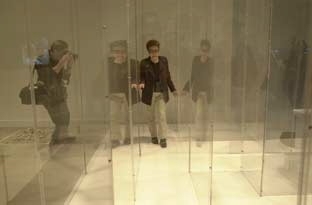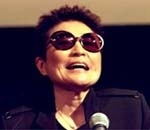Yoko Ono--conceptual artist, performance artist, composer, singer, videographer and peace activist--thought a lot about the MIT community as she prepared for her first American retrospective, "YES Yoko Ono," at the List Visual Arts Center.
At the Oct. 19 pre-exhibit press conference in Bartos Theater, she said she pondered what the MIT audience might like to think about. She decided we'd like the American flag brooch, the one studded with little red, white and blue gems with a gold flag pole and a wavy shape, she said. We'd like the story behind it involving ex-Beatle John Lennon, her husband, murdered in 1980.
"This is the brooch I gave to John as a present when he got his green card so he could work in the United States. It was 1975, the year Sean was born," she said, drawing back her exquisitely cut double-breasted black jacket with the subtle epaulets to reveal the brooch.
Ono was right about the jewelry and right about the story: reporters in attendance all wrote it down at once, immediately participating in a performance piece by Ono and us about celebrity, history, music, death, nationalism and fashion.
"YES Yoko Ono" displays objects created with exactly this type of warp-speed intimacy in mind. Bill Arning, curator of the List Center, later discussed the exhibit with Hiroko Kikuchi, education/outreach coordinator for the List Center and a performance artist herself, as part of the October Arts Colloquium. As he toured the exhibit with visitors, Arning described Ono as "fluently located among the worlds of art and rock music. Her presence, her political and spiritual sensibility are very powerful. Her persona and her achievements--the pioneering use of new technologies, like video, new materials, like Plexiglas--are legendary," he said.
"The Ono exhibit also brought a different crowd to the List--including people who came in, walked up to Ono and burst into tears," Arning added, rather loudly, as Ono's "scream vocalization" played constantly in the next room.
Kikuchi provided insights into Ono's use of symbolism. One reason Ono titled her series of self-published books "Grapefruit" is "that's what she thinks humans are like: thick skin on the outside, and you don't know if they're sweet or sour on the inside until you bite in," she said. Also, grapefruits unify differences--lemon and orange--into one, Kikuchi said.
The objects and events comprising "YES Yoko Ono" mix so many media that only a 350-page catalogue complete with CD, color plates and miles of text on art history and the avant-garde since 1945 could do them justice. (The catalogue, by Alexandra Munroe, Ono's exhibition curator, and Jon Hendricks, Ono's archivist and consulting curator, is available at the List.)
Arning and Kikuchi selected certain objects in "YES Yoko Ono" as particularly powerful and prescient of developments in the art world or proof that Ono and Lennon's love story is mind-bendingly romantic.
They focused on "Ceiling Painting" (1966), consisting of a ladder used by Lennon to view Ono's tiny written "yes" on a ceiling; "Cut Piece" (1965), a video of Ono sitting in a chair while her clothes are being cut off; and "Bed-in for Peace," the renowned video of Ono and Lennon camped out in a hotel bed after their wedding. "Bed-in for Peace" plays next to their billboard/poster, "WAR IS OVER If you want it" (1969).
One of Arning's personal favorites is "Box of Smile," a tiny box with a mirror inside that always delights him. "It's one of the most charming pieces of art ever," he said.
Kikuchi, who participated in Ono's performance piece on Oct. 21, commented on the veteran avant-gardist's wit. "I wore a blindfold. My instructions were, 'There is someone in the audience who has a tail. Find that person.' So I had to go around patting people on the bottom to see if they had a tail. Yoko was very kind and had a great sense of humor," Kikuchi said.
"That's the idea behind her work: there's a mystery behind everything. It's a mystery why we smile, but we do," she said.
GIVE PEACE A CHANCE
In addition to demonstrating the power of her personal creativity by engaging the group in artwork, Ono also discussed her beliefs about humanity, writ large, at the press conference in Bartos.
She was asked several times her opinion of the world since Sept. 11. The terrorist attacks and deaths of that day left her feeling "shocked, still in shock, and sharing the guilt felt by all of us who were not in the World Trade Center at the time," she said.
Asked what John Lennon would have thought, Ono said, "We must not act out of emotion. He was a very wise man. We all must be extremely delicate, careful and wise."
Ono contrasted the 1960s and the nascent 2000s, paying attention particularly to the differences for peace activists between the antiwar movement of the Vietnam era and the current peace movement.
"In the 1960s, some of us fought for peace. The government was very macho and we were macho peaceniks. Now, this situation is so complex that that would be dangerous. Now we should stand for peace, visualize peace instead," Ono said.
A version of this article appeared in MIT Tech Talk on October 24, 2001.







